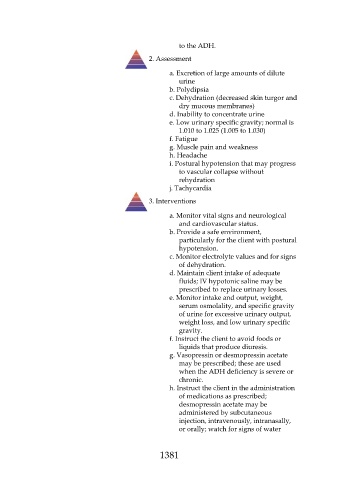Page 1381 - Saunders Comprehensive Review For NCLEX-RN
P. 1381
to the ADH.
2. Assessment
a. Excretion of large amounts of dilute
urine
b. Polydipsia
c. Dehydration (decreased skin turgor and
dry mucous membranes)
d. Inability to concentrate urine
e. Low urinary specific gravity; normal is
1.010 to 1.025 (1.005 to 1.030)
f. Fatigue
g. Muscle pain and weakness
h. Headache
i. Postural hypotension that may progress
to vascular collapse without
rehydration
j. Tachycardia
3. Interventions
a. Monitor vital signs and neurological
and cardiovascular status.
b. Provide a safe environment,
particularly for the client with postural
hypotension.
c. Monitor electrolyte values and for signs
of dehydration.
d. Maintain client intake of adequate
fluids; IV hypotonic saline may be
prescribed to replace urinary losses.
e. Monitor intake and output, weight,
serum osmolality, and specific gravity
of urine for excessive urinary output,
weight loss, and low urinary specific
gravity.
f. Instruct the client to avoid foods or
liquids that produce diuresis.
g. Vasopressin or desmopressin acetate
may be prescribed; these are used
when the ADH deficiency is severe or
chronic.
h. Instruct the client in the administration
of medications as prescribed;
desmopressin acetate may be
administered by subcutaneous
injection, intravenously, intranasally,
or orally; watch for signs of water
1381

